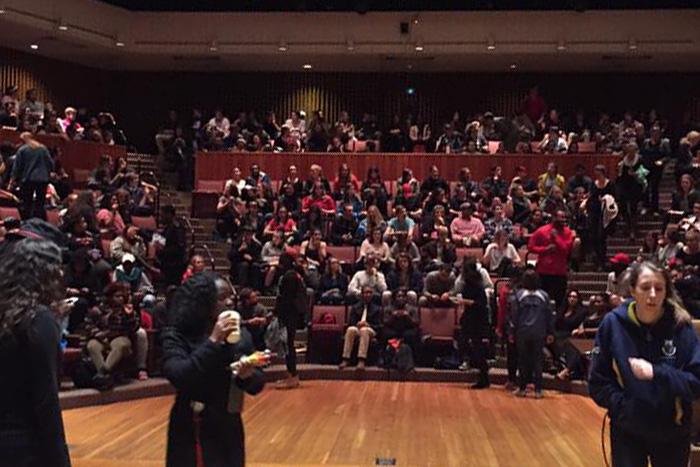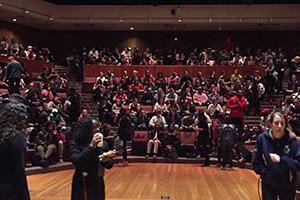Students Spark Conversation on Inclusivity

Anita Tuvin Schlechter Auditorium.

Hundreds of students along with some faculty and staff members gathered in ATS to discuss inclusivity at Dickinson and begin to develop a list of action items to improve the climate of respect and diversity on campus. Photo courtesy of Student Life & Campus Engagement.
Several Dickinson students spoke out during the annual Thanksgiving dinner, Wednesday, Nov. 18, to express concerns over the inclusiveness of the campus community. The following evening, hundreds of students along with some faculty and staff members gathered in Anita Tuvin Schlechter Auditorium (ATS) to discuss the issue further and begin to develop a list of action items to improve the climate of respect and diversity on campus.
(Update: View the list of concerns and recommendations that were presented and discussed on Jan. 31. On March 3, responses from the administration addressing the list were posted to the Why We Wear Black Movement - Dickinson College Facebook page.)
In response to the event and the issues it raised, President Nancy Roseman sent the email below to the campus community last week. Following that email is an article on the campus discussion written by Lizzy Hardison '16 for The Dickinsonian.
A Message From President Roseman
To the Dickinson community:
Last night in the Dining Hall, while I was away from campus due to a death in my family, students passionately expressed concerns of importance to our community.
I admire their courage and know that there is much work to be done to make Dickinson a truly respectful and inclusive community.
I am committed to working with everyone at Dickinson to improve our culture and equally committed to listening to students’ concerns and working to address them. We must all become more engaged in creating a culture in which each of us feels safe and respected.
You may not have experienced what the students who spoke last night described, but that doesn’t invalidate their concerns, nor exempt us from our collective responsibility to address issues that threaten our institution. We must work to build bridges of understanding and action in the days, weeks and months ahead.
I look forward to continuing to work with all of you as we tackle issues on our campus that mirror those issues in society as a whole.
Sincerely,
Nancy A. Roseman
President and Professor of Biology
720+ Attend Diversity Dialogue After Blackout Demonstration
by Lizzy Hardison ’16 (originally printed in The Dickinsonian)
On the heels of two student demonstrations earlier this week, more than 720 students, faculty and staff packed ATS on Thursday, Nov. 19 at 9 p.m. for a dialogue about inclusivity and diversity on Dickinson’s campus.
At the event, students shared their experiences with patterns of classism and racism on Dickinson’s campus, debated the merits of banning the anonymous social media application Yik Yak and reaffirmed their intent to present college administrators with a list of demands for improving the campus culture.
That list will be formulated based on input from attendees, who were all invited to identify one problem on campus, suggest a solution and method of improvement and list a demand for the college administration. Their written responses to these questions were collected at the end of the event, and organizers will read them in the coming weeks to compile a list.
Facilitator Alyson McAtee ’18 called the dialogue “a response to an event and a call for action,” referring to the student demonstration that took place on Wednesday, Nov. 18 during the Thanksgiving dinner in the dining hall, when approximately 25 students participated in a “blackout.” Students wearing black stood on tables and chairs while three students spoke for eight minutes about a culture of discrimination on Dickinson’s campus and an alleged lack of administrative action against bigoted behavior.
The blackout followed a Tuesday, Nov. 17 event organized by Marina Butler ’17, when posters in the HUB displayed anonymous statements about bias and discrimination based on race, sexuality, gender expression and mental health. Butler emailed images of the posters and a letter about the project to President Nancy Roseman and Joyce Bylander, vice president of Student Life.
The events at Dickinson come as college campuses across the country, including University of Missouri (Mizzou), Yale University, Occidental College and others, witness waves of protests against institutional racism. Facilitators McAtee and Jacqueline Amezcua ’19 opened Thursday’s dialogue by giving a timeline of events at Yale and Mizzou and saying that Dickinson students stood “in solidarity” with students at both universities.
McAtee and Amezcua then led the audience in a group activity where they read statements from Butler’s poster display and invited audience members to stand up if they agreed with the statement.
Approximately 30 students stood when McAtee read the statement, “I gravitate towards people like me because I feel I am not welcome among anyone else.” Four stood for the phrase “international students are encouraged to integrate at Dickinson, then excluded” and 30 stood for the statement “when I walk into a classroom for the first time, I look for other students of color to make sure I am not alone.” Between 15 and 20 stood for the statement, “I have been called a racial slur on Dickinson’s campus.”
The facilitators then asked students to contribute demands for the list they will present to the administration. Using notecards distributed at the start of the event, attendees were asked to write down one problem they identified on Dickinson’s campus, one solution, one method for realizing their solution and a person who could help them. Facilitators then invited attendees to share their demands with the audience.
Ryan Protter ’16 shared two demands: first, that the U.S. Diversity graduation requirement be made “more specific” and include “a history of marginalized people in the United States,” and second, that RAs be required to undergo diversity training and integrate dialogue opportunities into first-year residence halls.
Brander Suero ’17 demanded that the college hire more professors of color, and Samantha Mendoza-Ferguson ’16 made demands of the college Wellness Center.
“My demand is for more staff of color at the Wellness Center,” Mendoza-Ferguson said, who also demanded that the center employ “more than one psychiatrist” and require its’ staff to undergo diversity training.
Facilitators then opened the floor for open dialogue.
Katie Jarman ’16 responded to claims among the student body that the campus climate at Dickinson is “not as bad as it is at Mizzou and Yale.”
“We have a skewed perception of what discrimination looks like,” Jarman said. “What we’re dealing with is insidious and amorphous but that doesn’t mean it’s not there. Do we want to let is get as bad as it is [at Mizzou and Yale]? College campuses are about idealism, we have to respond to make it better and not let it get worse than it is.”
Morgan Bates ’18 spoke about what she called the “elephant in the room” of “classism on this campus.” “I don’t need the assumption that just because I go to an [expensive] school I can afford technology and equipment, I do not appreciate when vendors come to the HUB selling things that not everyone can afford,” Bates said. “This is something that affects a lot more students than you might think.”
Anh Tran ’18, who identified herself as an international student from Vietnam, spoke about the “marginalization of international students.”
“Dickinson advertises itself as diverse, but I don’t know if my definition of diversity is the same as Dickinson’s,” Tran said, adding that she has “always felt like an outsider” to conversations about diversity on campus.
Paulina Alexis Vidanez ’19 introduced the topic of banning Yik Yak on campus.
“We need to remove sources that people can hide behind to post bigoted statements,” Vidanez said.
Max Burrows ’19 was skeptical that banning the app would be effective, saying that “censorship isn’t the answer” to eliminating racist thoughts.
“That’s not getting to the root of the cause, just stabbing at it,” Burrows said.
Ian Wolf ’19 agreed, “blocking freedom of speech is not a way to fight racism.”
Other students suggested that a Yik Yak ban would deprive the community of the opportunity to see racist thoughts that might otherwise stay hidden.
“As hurtful as comments on Yik Yak have been, they have opened my eyes to hate that exists behind the covers,” Brendan Birth ’16 said. “If it’s banned, how will we know what that hate looks like?”
When the facilitators encouraged faculty and staff to contribute, they received support for their movement.
“We are faculty, we hear you, we will stand with you, we will carry on this mission,” said Kiersten Baughman, instructor of Psychology.
Mike Reed, vice president for Institutional Initiatives, said that in his 30 years working in higher education, there was a time when he and his colleagues “asked about the death of student activism.”
“This event and attendance is literally heartwarming. You have made me and my colleagues once again feel encouraged about student activism,” Reed said. He reminded the audience that “it’s on everyone to assume the responsibility of change, not just the minority and the marginalized,” and encouraged them to continue pressing for institutional reform.
“Hold our feet to the fire,” Reed repeated three times. “And you will see this come to fruition.”
Students raised concerns about sustaining social movements. Jonathan Long ’19 said that a “lack of ally training” on campus threatens the sustainability of cultural change.
“There’s no outlet for the majority to learn how to help the minority,” Long said.
The event concluded just after 10:30 p.m., when facilitators collected the notecards with student demands. Amezcua was “unsure” of the timeline for finalizing a list of demands, but said she was pleased with the evening’s results.
Manuel Ocampo ’19 called the dialogue “more successful” than similar events he has attended, but urged wider participation from the student body.
“It provided another platform for voices to be heard,” Ocampo said. “I loved that professors came out, but it’s the same set that always come. We need more community involvement in these issues. We see professors as role models because they are the ones here to teach us, and we really look up to them when they come to show their support at these kinds of events.”
Evan Young, assistant professor of History, called the event “wonderful.”
“What I was most struck by both in the cafeteria and tonight was how eloquently the students voiced their concerns, trying to generate both dialogue and concrete ways to make this campus a more inclusive community,” Young said.
Rulaiha Taylor ’18 praised the “emphasis on the fact that people of color does not just mean black, but encompasses a spectrum of races.”
“There is a huge misunderstanding on this campus among people of color who do not realize they are a part of this movement for a voice and for safe spaces,” Taylor said. “International students’ experiences count—coming to this country and being thrown into the systematic oppression here is harsh.”
Crystal Moten, associate professor of History, said that she was “amazed and inspired by students’ determination to make their voices heard.” Moten, who studies the Civil Rights Movement, said that opportunities for dialogue are crucial for avoiding the confrontations like those that transpired at Mizzou and Yale.
“When we think about the Civil Rights Movement, we think about direct actions and confrontations when a conversation has not been had,” Moten said. “The beauty of this [campus movement] is that dialogue is in process, that conversation is being had. This is really a moment that is pregnant with possibility.”
Learn More
- "Dickinson students organize open discussion about race, diversity" by Jessica Sykes '16, The Sentinel
- "Students Stage Black Out, Calling it the Start Of a Movement" by Jessica Sykes '16, The Dickinsonian
- Latest News
Published November 23, 2015